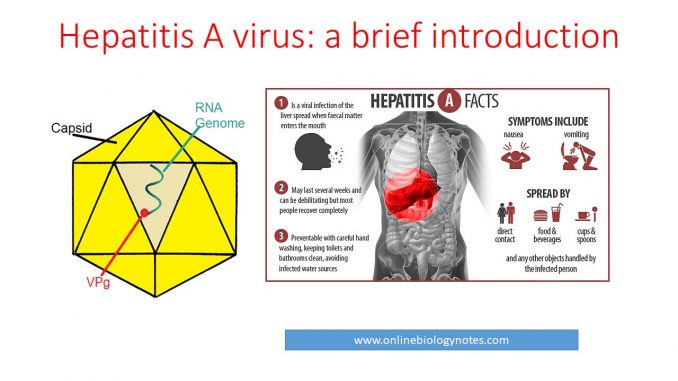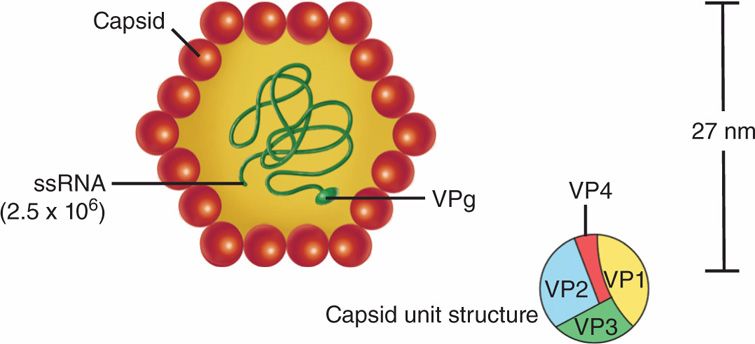
Hepatitis A virus (HAV): properties, classification, mode of transmission, pathogenesis, clinical features and laboratory diagnosis
Properties and classification of HAV:
- Hepatitis A virus (HAV) ia a member of Family Picornaviridae. It was previously classified as Enterovirus 72. Now it is assigned to new genus Heparnavirus (Hepatovirus).
- HAV is a RNA virus.( 7.48kb )
- Genome: the genome is single stranded positive sense RNA (+ss RNA). The 3′ end of RNA is polyadenylated and 5′ end consists of viral protein VPg. There are 4 viral proteins ie. VP1, VP2, VP3 and VP4. (* VP1 and VP3 are major antibody binding site)
- Shape: Small spherical
- Capsid: icosahedral
- Size: 27nm
- Envelope: absent (No envelope)

- Replication: In cytoplasm of Host cell
- Resistance: HAV is stable to treatment with 20% ether, acid (pH 1.0 for 2 hours), heat(60C for 1 hours) and temperature of 4C or below.
- Susceptible: HAV is destroyed by Autoclaving, boiling in water for 5 minutes, by dry heat (180 C for 1 hours), by UV light, formaldehyde (1: 4000 at 37C for 72 hours0 and chlorine (10-15 ppm for 30 minutes).
- Hepatitis A virus causes an acute highly contagious hepatitis, also known as infectious hepatitis in children and young adults.
- Classification of Heparnavirus; Hepatitis A virus is the only known species of the genus Hepatovius. There is only one serotype of HAV and 4 genotypes
Mode of transmission:
- HAV is mainly transmitted through Faeco-oral route by eating/drinking contaminated food and water.
- also transmitted by direct person to person contact
- virus is also transmitted by food handlers and children
- Rarely transmitted by blood products, blood transfusion or intravenous drug use.
- HAV is excreted in faeces during incubation period of 3-5 weeks
Pathogenesis of Hepatitis A virus:
- Human is the primary reservoir of Hepatitis A virus. The virus may survive outside the body for months.
- HAV infection is caused by ingestion of contaminated foods or water. The virus first multiplies in the intestinal epithelium and then enter the blood stream and then migrates to liver parenchymal cells.
- HAV attaches to liver cell through Ig-like cellular receptor on the host cell and enter inside the cell by receptor mediated endocytosis.
- Inside the endosome, virus releases VPg protein which creates pores on the endosomal membrane and releases viral genome in the host’s cytoplasm and damage the hepatocytes.
- Virus multiplication occurs in hepatocytes and Kupffer’s cells causing monuclear infiltrate, ballooning of hepatocytes, degeneration and acidophilic bodies in the hepatocytes.
- Liver damage is not due to HAV but rather due to immunological response by cytotoxic T cells.
- Newly synthesized viruses in liver cells sheds into bile ducts and excreted in faeces.
- HAV occasionally caused transient viremia.
- Rapid infection of virus is faster than development of immune response
Clinical features of Hepatitis A:
- The incubation period is between 2-1o weeks.
- After about 2 weeks of infection, virus is detectable in the liver blood and faeces.
clinical features includes-
I. Mild illness without Jundice with little liver cell damage
- Loss of appetite
- Nausea
- Gastrointestinal upset
- Enlarged and painful liver
II. Acute hepatitis with jaundice with severe liver cell damage
- More acute symptoms especially nausea
- Loss of appetite
- Fever
- Jaundice
- Headache
- Pain in muscle and joint
- Skin rashes
Laboratory diagnosis of Hepatitis A:
Specimen: faece, blood
1. Liver function test (LFT):
- Increase in both Alanine aminotransferase (ALT) and Aspartate aminotransferase enzyme by 4-100 times in Hepatitis patient than normal.
- A sharp rise of ALT with short duration (4-20 days) is suggestive of HAV infection.
- Increase serum bilirubin level (5-20 mg/dl)
- Increase serum globulin level
- Decrease in serum albumin level
2. Serology:
- Antibody detection: rapid kit for detection of anti-HAV IgM in serum
- Antigen detection: detection of hemagglutination antigen or virus particle in faeces
3. Virus culture:
- culture of HAV is difficult and takes upto 4 weeks to get result
- In cell line culture, virus does not replicate well and produces variability till cytopathetic effects.
4. Molecular diagnosis:
- Electron microscopy
- RT-PCR

Nice one please write a note on DNA repair system and homologous recombination